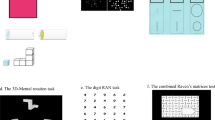Abstract
Difficulties in students’ understanding of the spherical model of the Earth have been shown in previous studies. One of the reasons for these difficulties lies in beliefs and preliminary knowledge that hinder the interpretation of the scientific knowledge, the other reason may lie in the low level of verbal and visuo-spatial abilities. The study aims to investigate the effect of verbal and visuo-spatial abilities, but also that of preliminary knowledge on the later development of the knowledge of the Earth in school. 176 schoolchildren (96 boys and 80 girls) from five schools were tested; the mean age of the children during the first interview was seven years and eight months. All students were interviewed twice – in grades 1 and 2, before and after they had learnt the topic in school. Factual, scientific and synthetic knowledge was assessed. The facilitative effect of visuo-spatial and verbal abilities and preliminary factual and scientific knowledge on students’ knowledge of astronomy after having learnt the topic in school was shown. In contrast, the hindering effect of synthetic knowledge was not found.
Similar content being viewed by others
References
Albanese, A., & Vicentini, M. (1997). Why do we believe that an atom is colourless? Reflections about the teaching of the particle model. Science and Education, 6, 251–261.
Baxter, J. (1995). Children’s understanding of astronomy and the Earth sciences. In S. Glynn, & R. Duit (Eds.), Learning science in the schools (pp. 155–178). Mahwah, NJ: Erlbaum.
Blades, M., & Spencer, C. (1994). The development of children’s ability to use spatial representations. In H. W. Reese (Ed.), Advances in child development, 25 (pp. 157–199). San Diego: Academic Press.
Carretero, M., & Voss, J. (Eds.) (1994). Cognitive and instructional processes in history and the social sciences. New Jersey and Hove: LEA.
Chi, M., & Rees, E. (1983). A learning framework for development. Contributions to Human Development, 9, 71–107.
Diakidoy, I.-A., & Kendeou, P. (2001). Facilitating conceptual change in astronomy: A comparison of the effectiveness of two instructional approaches. Learning and Instruction, 11, 1–20.
Diakidoy, I.-A., Vosniadou, S., & Hawks, J. (1997). Conceptual change in astronomy: Models of the Earth and of the day/night cycle in American-Indian children. European Journal of Psychology of Education, 12, 159–184.
Hoyle, R. (Ed.) (1995). Structural equation modeling. Thousand Oaks: Sage.
Kikas, E. (2003). Constructing knowledge beyond senses: Worlds too big and small to see. In A. Toomela (Ed.), Cultural guidance in the development of the human mind (pp. 211–227). Westport, Connecticut and London: Ablex.
Kurdek, L., & Sinclair, R. (2001). Predicting reading and mathematics achievement in fourth-grade children from kindergarten readiness scores. Journal of Educational Psychology, 93, 451–455.
Luria, A. R. (1969). Vyshije korkovyje funktsii tsheloveka i ikh narushenija pri lokal’nykh porazenijakh mozga. (Higher cortical functions in man and their disturbances in local brain lesions.). Moscow: Izdatel’stvo Moskovskogo Universiteta.
Mali, G., & Howe, A. (1979). Development of Earth and gravity concepts among Nepali children. Science Education, 63, 685–691.
Maria, K. (1996). A case study of conceptual change in a young child. The Elementary School Journal, 98, 69–89.
Muthen, L., & Muthen, B. (1998). Mplus. The comprehensive modeling program for applied researchers. Los Angeles: Muthen and Muthen.
Nobes, G., Moore, D., Martin, A., Clifford, B., Butterworth, G., Panagiotaki, G., & Siegal, M. (2003). Children’s understanding of the Earth in a multicultural community: Mental models or fragments of knowledge? Developmental Science, 6, 74–87.
Nussbaum, J. (1979). Children’s conception of the Earth as a cosmic body: A cross-age study. Science Education, 63, 83–93.
Rolfhus, E., & Ackerman, P. (1999). Assessing individual differences in knowledge: Knowledge, intelligence and related traits. Journal of Educational Psychology, 91, 511–526.
Samarapungavan, A., Vosniadou, S., & Brewer, W. (1996). Mental models of the Earth, sun, and moon: Indian children’s cosmologies. Cognitive Development, 11, 491–521.
Schnotz, W., Vosniadou, S., & Carretero, M. (Eds.) (1999). New perspectives on conceptual change. Amsterdam: Pergamon.
Siegal, M., Butterworth, G., & Newcombe, P. (2004). Culture and children’s cosmology. Developmental Science, 7, 308–325.
Sneider, C., & Pulos, S. (1983). Children’s cosmographies: Understanding the Earth’s shape and gravity. Science Education, 67, 205–221.
Spelke, E. (1991). Physical knowledge in infancy: Reflections on Piaget’s theory. In S. Carey, & R. Gelman (Eds.), The epigenesis of mind: Essays on biology and cognition (pp. 133–169). Hillsdale, New Jersey: Erlbaum.
Toomela, A. (1999). Drawing development: Stages in the representation of a cube and cylinder. Child Development, 26, 234–247.
Toomela, A. (2002). Drawing as a verbally mediated activity: A study of relationships between verbal, motor, and visuospatial skills and drawing in children. International Journal of Behavioral Development, 26, 234–247.
Vosniadou, S. (1994a). Capturing and modeling the process of conceptual change. Learning and Instruction, 4, 45–69.
Vosniadou, S. (1994b). Universal and culture-specific properties of children’s mental models of the Earth. In L. A. Hirschfeld, & S. A. Gelman (Eds.), Mapping the mind: Domain specificity in cognition and culture (pp. 412–429). Cambridge, Massachusetts: Cambridge University Press.
Vosniadou, S. (2003). Exploring the relationships between conceptual change and intentional learning. In G. Sinatra, & P. Pintrich (Eds.), Intentional conceptual change (pp. 377–406). Mahwah, New Jersey and London, UK: LEA.
Vosniadou, S., & Brewer, W. (1992). Mental models of the Earth: A study of conceptual change in childhood. Cognitive Psychology, 24, 535–585.
Vosniadou, S., & Brewer, W. F. (1994). Mental models of the day/night cycle. Cognitive Science, 18, 123–183.
Vosniadou, S., Skopleiti, I., & Ikospentaki, K. (2004). Modes of knowing and ways of reasoning in elementary astronomy. Cognitive Development, 19, 203–222.
Author information
Authors and Affiliations
Corresponding author
Rights and permissions
About this article
Cite this article
Kikas, E. The Effect of Verbal and Visuo-Spatial Abilities on the Development of Knowledge of the Earth. Res Sci Educ 36, 269–283 (2006). https://doi.org/10.1007/s11165-005-9010-5
Received:
Accepted:
Published:
Issue Date:
DOI: https://doi.org/10.1007/s11165-005-9010-5




